
| Classic Performance Products makes it easy to steer your
1967-72 Chevy truck |
|
 |
 |
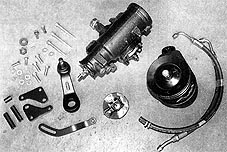
|
If you want biceps like Atlas and forearms like Popeye, you
can always join one of those exclusive, high-priced health clubs. Or you
can simply buy an old pickup with manual steering and do the patented "CLASSIC
TRUCKS parking lot workout" once a day!
All kidding aside, driving a vintage truck with manual steering can be a
real drag, especially in tight parking situations. And the problem is simply
compounded if your ride has wide radial rubber in place of the skinny stock
bias ply tires. That's a fact that Craig Watts quickly
learned with his daily-driven '68 Chevy shortbed. And for Craig all that
exercise was a little excessive. We're sure there are plenty of you who
are in the same predicament as Craig, and you'll be happy to know that converting
a '67-72 Chevy over to power steering is a fairly easy endeavor. Factory
power steering boxes from '69-87 half-ton, two wheel drive pickups are direct
bolt-ins, requiring only minor bumper bracket modification on '67-68 and
some '69 trucks. |
Likewise, power steering pumps From similar applications will
also work. The main thing you'll want to remember is to get a pump that
matches your steering box; that is, one that uses the same style of hoses
and fittings (flared end, O-ring, etc). Being wary of junkyard parts, Craig
contacted Classic Performance Products for a rebuilt power steering box
and pump for his pickup. In addition, CPP supplied him with a Pitman arm,
hoses, and a power steering pump bracket to help complete the conversion.
And with cameras in hand, we followed along as Craig made the swap. As expected,
the conversion was pretty straightforward. The only significant hiccup we
encountered involved the pump bracket and pulley. On Craig's stock 307,
the aftermarket bracket positioned the pump in a location where the alternator
belt would rub against it. |
Rather than replace the stock altemator bracket with an aftermarket
one (a possible solution), Craig used a factory power steering pump bracket
that he had laying around. The OEM bracket required minor modification to
accept the later-style pump, and we were forced to mix and match pulleys
from Craig's parts bin to get the belt to align (our winning combination
was a big-block power steering pulley on the crank and a single-belt pulley
on the pump). In other words, there's not a "one size Fits all" bracket for every application, so you'll want to
do some research to see what will work with your particular truck, engine,
and accessory combination. Our suggestion would be to trial fit
your power steering pump before proceeding with the rest of the installation.
With that word of advice, let's take a look at the conversion and see what
it takes to get a Chevy to steer with ease. |
These are the parts we got from Classic Performance
Products (CPP) for this installation. They include a rebuilt power steering
box and pump, hoses, and a new rag joint and Pitman arm. An aftermarket
power steering pump bracket (shown) is also available from CPP. |

|
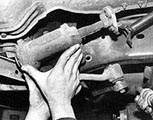 |
| The first step was disconnecting the rag joint and Pitman
arm, then unbolting the stock manual box from the frame. On these trucks,
the box is mounted on the outside of the left frame rail. |
|
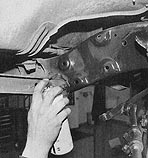 |
| While the box was off, Craig cleaned up the frame rail and
covered the bare metal with some semi-gloss black paint. |
|
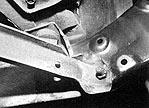 |
| On earlier trucks ('67-68, and some '69s), you'll usually
need to cut or grind a notch out of the bumper bracket to provide clearance
for the longer power steering box. |
|
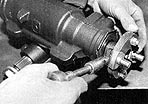 |
| Craig made sure to bolt on the new rag joint prior to installing
the steering box. |
|
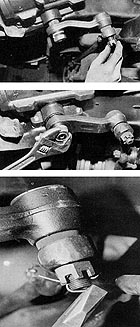 |
| Here's one of the lessons we learned the hard way: The Pitman
arm needs to be installed before the steering box is bolted into place.
We failed to do this, and ended up having to unbolt the box to maneuver
the arm into the center link. Also, make sure the steering box and all related
steering linkages are centered in their travel before tightening everything
down. |
|
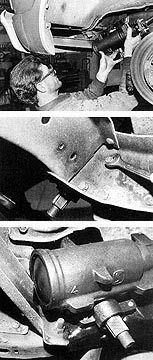 |
| The box was then hoisted into place and bolted to the frame
and steering shaft. You can see how proper fit was afforded by cutting the
notch in the bumper bracket. |
|
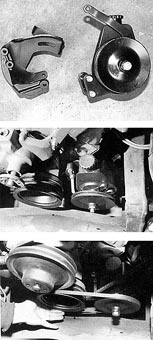 |
| With the box in place, we moved on to mounting the power steering
pump. The aftermarket brackets we got from CPP (shown here on the pump)
created interference with the alternator belt on Craig's stock 307 (which
has a left-side mounted alternator). So we ended up using a stock-style
bracket (left) that Craig had picked up at a swap meet. With minor alterations
it worked fine, but we did have to mix and match pulleys to achieve proper
belt alignment. A big-block pulley on the crank and a single-belt pulley
on the pump worked for our particular application. |
|
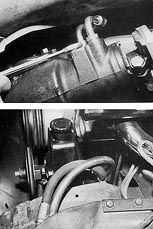 |
| After clearing the hurdle of mounting the power steering pump,
all that remained was installing the hoses, filling the system with fluid,
and checking for leaks. |
|
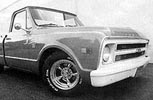 |
| Conversion complete! Craig's a lot happier cruising his Chevy
now that it has power steering. And he's no longer afraid to navigate those
parallel parking spaces! |
|
|
|
|
| Classic Performance Products 378 E Orangethorpe
Ave., Placentia CA 92870 Tech Line 714-522-2000 |
 |
TECH
| BOOKS | SUSPENSION
| BRAKES | STEERING | CONTACT
US | HOT PRODUCTS |

|
| © Classic Performance Products. This "website"
and all contents are property of Classic Performance Products.
Prices subject to change without notice. Not responsible for
errors or omissions. Please note that kits & prices
may vary between certain applications. |
|
|
|
|
|
|
|